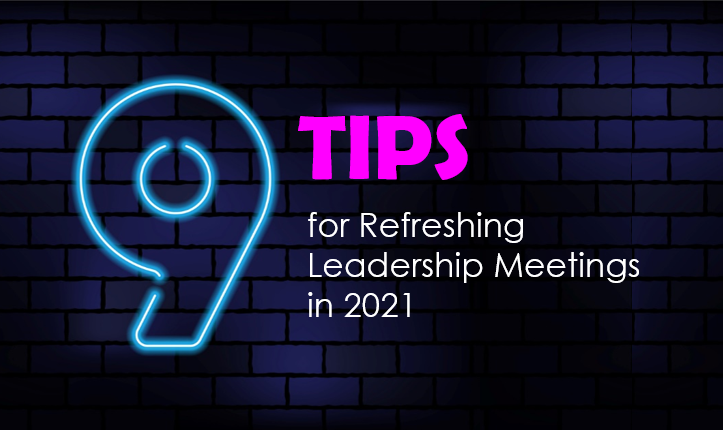
Facilitate the hell out of your next executive session
Leave them wanting more. Is that even possible with a meeting? People want fewer meetings, right? Or maybe you’re doing it wrong.
2021 is the perfect opportunity for a reset. Next time you facilitate an executive meeting, make it a satisfying experience: effective, focused, respectful, and even fun.
- Do your research. Nothing takes the wind out of your sails like the participants realizing you don’t know enough to run the meeting. Don’t make them stop and educate you. Make sure you’re rock-solid on the facts, figures, and history you need.
That starts with the Why. After you think you’re clear on the goals of the session, ask the participants. Send each one a personal invitation and ask them to answer one question:
“Why do you think we need this meeting?”
This will surface misunderstandings so you can resolve them before everyone shows up. It also gives each attendee some buy in – it’s a trick of psychology; you’re getting them on the record saying it’s important.
- Focus. We all know “Begin with the end in mind,” and that’s right. Start the session by confirming the goal. Here are a few more tips:
Limit attendees. In The Surprising Science of Meetings, Steven Rogelberg says the ideal size is seven participants. AND that decision-making effectiveness decreases 10% with each additional attendee! Balance your need to have all the right decision-makers in the room with the value of your outcomes.
Limit devices. I once sat in an exec meeting next to a new team member who kept his laptop open. I was the only one who could see that he wasn’t taking notes; he was reading the news, checking stock performance, and watching hockey highlights on mute. (I swear.) He didn’t last long in the company. Either the meeting is important or it’s not. If it’s not, then cancel it. If it is, then silence phones and close the laptops. If someone gets a call and has to take it, stop the meeting for a break. This has the double-whammy of respecting the call-taker (because you can’t continue without her) and pressuring her to get off the phone fast.
Use a “parking lot.” When someone goes off topic, stop, reset, and document that point on a flipchart page, whiteboard, or notes window. Promise not to lose that thread and follow up after the meeting.
- Limit session time. “I don’t need time. I need a deadline.” ~ Edward Kennedy Ellington. Duke was right— time limits work. Rogelberg and others recommend scheduling hour-long meetings for 50 minutes. If you truly need more time, break it into 50-minute sessions with specific milestone goals for each. And chunking up your process lets you use another technique…
- Delay decisions. Why do we say “I want to sleep on it?” Because it works. Time for reflection and synthesis yields better ideas. We’ve all sent that follow-up email saying, “Hey, I just had another idea” or “We didn’t have time to cover this, but…”
So design that into your session. Up front, explain that you will make no firm decisions at the end of any one meeting. Everyone will go away, let their “back burner” brilliance work, and come back together to confirm. This works well if you have broken your process into multiple short sessions. Assign a milestone goal for Session One, then use the first ten minutes of Session Two to play back tentative decisions, bring in new info, and make a final call.
- One up, one down. This concept comes from the military, but I know it as a best practice in my kids’ Montessori preschool. Each class had two teachers managing 25 kids working independently or in small groups. Rather than the goat rodeo you might expect, the classroom worked beautifully. “One up, one down” meant that when one teacher was focused on teaching students (in a chair or on the floor) the other should be standing, with a view of the whole group.
In an exec session, there should be at least one person focused on documenting, fixing, or providing support; the other should have eyes on the room, to manage the discussion and progress.
- Document, document, document. Executives have zero time for your shenanigans. They don’t want to repeat themselves, argue about what was said last time, or struggle to understand what’s going on. So make sure you collect and replay all essential information.
Record faithfully. If it’s ok with participants, record the audio and/or video of your meeting. That’s the only fool-proof way to make sure you know what happened. If you can’t do that, take copious notes. And commit to being the historian, calling up meeting minutes, inputs, and outputs in real time when asked. Use these to produce executive summaries at milestones and at the end of the process.
Dampen the politics. Sometimes it matters who’s talking. Junior participants might not hold the floor as long, or might get a quick rebuttal. But when you record and play back what happened, you can give all good content equal weight, removing any hierarchical barriers to a good idea.
- All brains matter. People process and retain information differently, so provide as many channels as you can. We default to bullet points and flow charts, with a voice-over from the facilitator. But that’s not the only way. Consider these:
Silent reading. Give the group information to read as an input to your discussion. Some people think better when eyes aren’t on them and people aren’t speaking.
Listening. The growth of podcasts and video books has revealed a segment of people who love to learn with their ears, minus other distractions. Use audio content in the session or as pre-work.
Video. Moving pictures really work for some people, especially with retention. Video has it all: sound, images, and verbal content.
Graphic documentation. This is a powerful way to capture ideas and decisions. Use a graphic artist to illustrate content in real time; you’ll end up with a graphic that conveys more than a list of bullet points ever could. Graphic documentation is a great touchstone to use after the meeting—post your graphic in a space where people can revisit it and use it to communicate to a wider audience.
- Be tenacious. Even the best outputs can evaporate after you all leave the room. People ignore emails, crises emerge, and enthusiasm fades over time. Don’t let go. Set milestones for feedback, new meetings, and other next steps. Get commitment before you leave the room. If necessary, unblock the logjams with one-on-one conversations over time.
- Lighten up. Why so serious? We can accomplish real work and have fun at the same time. We recently asked an exec team to come up with their own theme songs. Each member chose their own song, then they composed a song to represent themselves as a team, real-time. We captured and produced their work of art after the session. It was a good time, but it wasn’t just a good time—it surfaced and confirmed their strengths and cohesion. Think about how to brighten up your session. Use stunning graphics, gamify your process, or use a new environment for the meeting. Fun doesn’t have to get in the way—bake it into the work.
Meetings have such a bad reputation, especially among busy executives. But if you do it right, they’ll accept your next invite with a smile.




